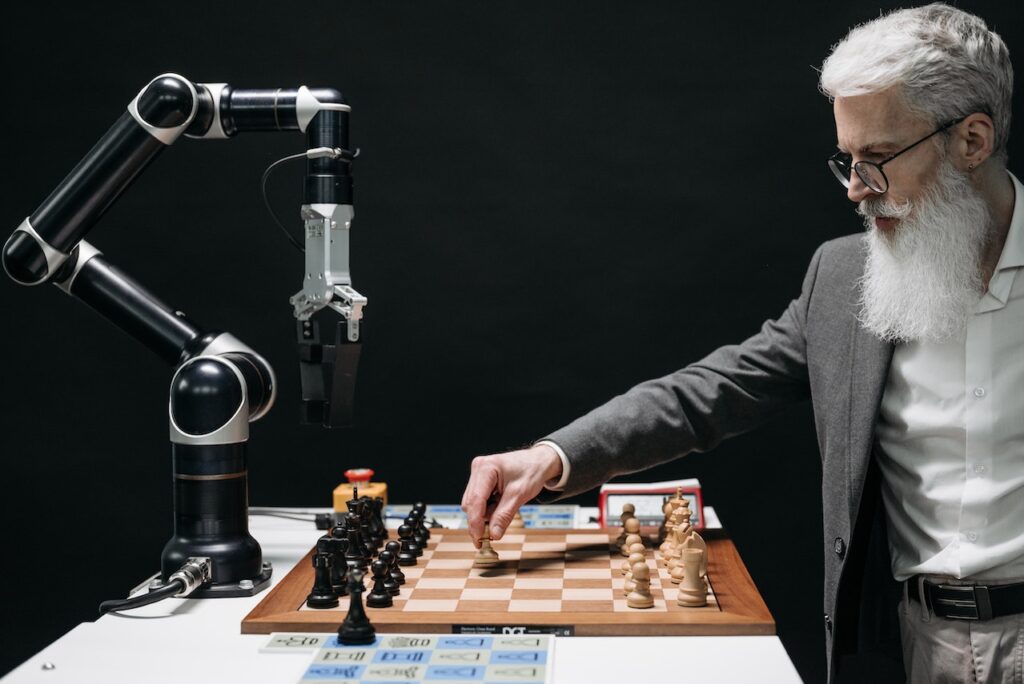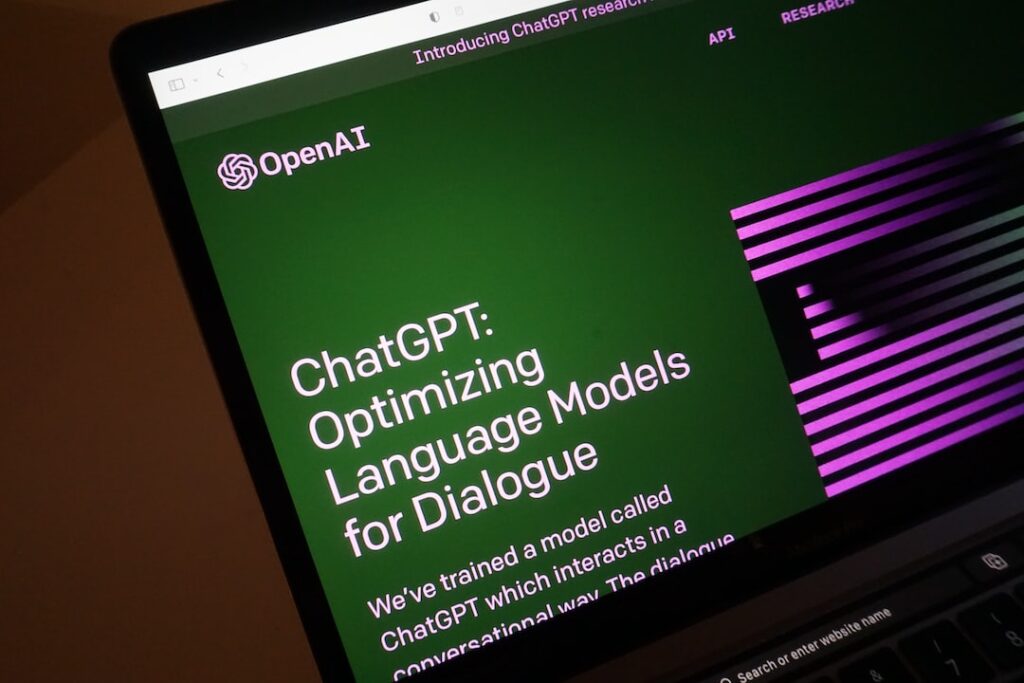If you were to judge on the recent fever pitch stoked by Open.ai’s ChatGPT, you’d think that artificial intelligence and AI tools were brand-spankin’ly new. Like people have only been unboxing it within the last handful of months.
In reality, though, AI has been around for decades. It was first developed starting in the 1940s and the first successful AI software program dates to 1951.
So why, then, is:
- AI suddenly dominating seemingly every facet of business and daily life
- Everyone losing their minds over ChatGPT
- The marketing machine slapping “AI” onto literally every freakin’ thing
Seriously, what’s up with all this? What’s it mean for us as people and societies? Let’s tease it apart a bit.
*** Disclaimer — This post has affiliate links. If you click on my affiliate links, I may be compensated. Learn more. ***
But First, Common AI Terms
Just to make sure we’re all talking the same language….
- Artificial intelligence (AI) is the development of computer systems that can think and learn on their own.
- Computer cybernetics is the study of the control and communication of intelligent systems.
- Machine learning (ML) is the process of using statistical techniques to give computers the ability to learn from data without being explicitly programmed.
- Neural networks are AI systems modeled on the neural connections of the human brain and used to recognize patterns and make predictions.
- Large language model (LLM) is an AI technology that uses neural networks to generate text from large datasets of text.
- Natural language processing (NLP) is an area of AI focused on enabling computers to understand, interpret, and produce human language.
I promise this isn’t just a superfluous vocab cram sesh. We’ll dig into all these concepts more throughout the post.
What Is Artificial Intelligence?
AI has been a buzzword for the last few years, but what does it really mean?
AI Made EZ
AI is the development of computer systems that can think and learn on their own. It’s a way to give machines the ability to solve problems, understand language, recognize objects, and make decisions. You’ll find traces (or big fat tranches) of AI in everything from self-driving cars to voice assistants to medical diagnostic tools and beyond.
AI has the potential to revolutionize how we interact with technology and function in our everyday lives. It’s an exciting field that’s constantly evolving.
What AI Is NOT
Merriam-Webster defines intelligence as “the ability to learn or understand or to deal with new or trying situations.”
Some argue that AI isn’t really artificial intelligence, though. They assert that legit human intelligence also includes components of creativity, intuition, and other as-of-yet-uncopyable mental, emotional, and intellectual qualities.
They contend that AI is just a computer that’s very fast and good at crunching massive pools of data and quickly regurgitating that to us in a way that’s easier for us laypeople to grasp. In their view, AI isn’t creating. It isn’t generating anything new or truly unique. It’s piggybacking off the hard work of flesh-and-blood people and spitting out a copycat mash-up. Imitation at best, and downright stealing or spreading of false information at worst.
This debate is likely to continue for a looooong time. Which is why you’re starting to see lawsuits over copyright concerns. And calls for a pause in disseminating advanced AIs until we have a chance to think it through and establish some protective guardrails. All this is definitely something to stay tuned to!
The ChatGPT Craze
So, how does ChatGPT fit in to the artificial intelligence landscape?
ChatGPT, which stands for “Conversational Generative Pre-trained Transformer,” is a newer AI technology that — as you know unless you live under a rock in a dead zone — is revolutionizing the way we engage with computers for work, school, or personal purposes.
How ChatGPT Works
This tool generates human-sounding responses to our input (aka prompts) using statistical modeling and probabilities. The technology leverages a number of AI techniques to be able to create/compile and return natural language responses.
For instance, it uses natural language processing (NLP) to understand the context of conversations and respond appropriately. It also uses machine learning (ML) algorithms to train the model on the available data so it can better anticipate the kinds of questions we might ask and provide more relevant answers. In other words, the AI elements of ChatGPT are what gives it the ability to chat with us as if we were talking to another person.
Remember, ChatGPT’s Not Perfect
Don’t get duped or lulled into laziness. ChatGPT has serious caveats, limitations, and shortcomings that users must account for, such as.
- As of April 2023, ChatGPT has only been trained on the internet through September 2021. So, it can’t tell you who won the election in Finland this year (unless you feed it the URL to a website that contains that info).
- It’s a backward-look, forward-projecting program. Yeah, the past has patterns, which if examined thoroughly, can be predictive of the future. But it’s still just an educated guess.
- Just because ChatGPT’s responses totally slap, doesn’t mean they’re true or factually accurate. You have to fact-check e.v.e.r.y.t.h.i.n.g.
- ChatGPT has a known bias toward giving an answer even when it may not have the info to support its response. Plus, it may be answering based on outdated or incorrect info.
- ChatGPT is black-box. People outside of Open.ai don’t know what the algorithms are or what the exact training set was/is. And, I don’t think anyone can be sure of the exact sources ChatGPT is drawing from for any given response.
- Speaking of sources, you can ask ChatGPT to reference the information in its response. But, often it gives citations that don’t actually exist or dead links. So, how’s that helpful? (It’s not.)
- Without knowing the sources for training material, it’s really hard to say if ChatGPT is copying (read: plagiarizing) bits and pieces from around the web. (Which is why you should also use a plagiarism checker on AI-generated content.)
- People are often so fixated on what the tech is churning out that they forget the tech was conceived and built by humans. With the touch of human hands comes the fingerprint of a host of biases — like what’s appropriate training data, what’s offensive material, etc. This can radically skew the responses one gets from prompts.
- ChatGPT’s content filters (which weed out content that’s deemed too harmful or provocative by ChatGPT’s makers) are moderated by actual people.
So, no, I don’t think the robots are gonna rise up and conquer us or replace us (yet, based on ChatGPT as the benchmark). There’s room for all of us. There’s a time and place for tech, and my guess is that it’ll always need a real-live person involved in some capacity.
Not the Only Game in Town
There are plenty of other AI-based or AI-injected tools out there, including other AI writing assistants (e.g., Jarvis, WordHero, even Notion has one now). ChatGPT is just one of the flashy elites having its moment in the sunshine.
In fact, this very blog post was written with the assistance of AI (Bramework, a long-form AI writing assistant). It exemplifies how generative AI tools can morph how we work. It’s also an example of why we need squishy brains and not just CPUs churning out the content… IMHO, it is possible to meld the best of man and machine to produce optimal outputs.

Let’s Talk Computer Cybernetics for a Hot Nanosec
Computer cybernetics is the study of systems that can process information and react to changes in their environment. It’s a cornerstone for AI development, as it allows for machines to be able to think and learn on their own.
We’ve been using the fruits of computer cybernetics research for ages. Ever heard of automation? Or maybe self-regulating systems?
Post-WWII Tech Race
After World War II, advancements in computing technology and AI took off.
The US and the Soviet Union had both invested heavily in technology during the war. And the subsequent Cold War saw a race between the two countries to develop the most advanced computer technologies.
This spurred an unprecedented level of research and innovation, which eventually led to the development of AI technology that is now so commonplace.
AI Applications Are Nothin’ New
Post-WWII computing and AI advancements allowed for the development of some of the most commonplace tech tools — one we rely on on the daily. Here are just a few examples of applications powered by AI.
- Automation is the process of having machines or computers perform tasks that would normally require human intervention. Automations are usually used to increase efficiency and minimize the amount of time and labor expended on a task. Automations can be used to process orders, manage databases, and compile reports, among other things. Examples: Hubspot, ThriveCart, ConvertKit
- Virtual assistants are AI-enabled software programs that are designed to provide users with helpful information, such as a set of instructions, answers to questions, and other types of guidance. Virtual assistants can be found in various forms, such as voice-activated assistants like Alexa, Siri, and Google Assistant, as well as text-based assistants like chatbots. Example: Canva‘s Virtual Assistant
- Chatbots are AI-based software programs that are capable of carrying out conversations with humans. They are programmed to understand natural language, so they can recognize when a user is asking a question and respond with an appropriate answer. Chatbots are used in many industries, ranging from customer service to education to healthcare. Example: HubSpot Chatbot Builder
- Suggest-ahead text is a feature found in many search engines and word-processing programs that predicts what the user is typing and offers suggestions for how the user might finish the phrase. This feature leverages AI to quickly analyze a user’s typing patterns and make suggestions based on those patterns. Suggest-ahead text can help users find what they’re looking for faster and save time in the process. Examples: Google Search, Microsoft Word
- Spelling and grammar checkers tap in to the power of LLMs, NLP, and ML to perform text analyses to find spelling, grammar, and word usage errors and supply possible corrections. Example: Grammarly
With this broader-than-just-ChatGPT view, you can see how prolific AI actually already is today. And how leveraging AI functionality can — in many ways and situations — help us be more efficient, productive, accurate, dot dot dot.
Next-Gen Shtuff
I think it’s safe to say that this steamroll of AI-leveraging tools — and the hullabaloo surrounding them — is here to stay. And will just expand.
But, what that looks like is anyone’s guess. Not even the AIs have a crystal ball that lets them definitively gaze around the corner.
AI Hype Driven by Marketing
So, is artificial intelligence and all its incarnations substance or fluff? IMHO, it’s some of both. And I say this as a person in the marketing field.
There are certainly amazing implementations of AI — like tools that make our lives better in meaningful ways — and stellar use cases for those tools. Buuuut, there’s plainly also a lot of shystering going on.
And I’m not the only one who thinks this. Check out Adam Conover’s AI is BS video for a pretty passionate take on this topic.
Marketing Departments Trying to Capitalize on a Trend
Things that used to just be “software” or “apps” went through a metamorphosis. They started as tech caterpillars. Then they tacked on the word “smart” and became “connected” apps — a chrysalis stage if you will. Now, they’re emerging as AI butterflies, just by using the descriptor “AI” somewhere nearby the product name.
Allure of AI for Product Marketers
Who knows what exactly goes on in the minds of marketers. Here are a couple of theories, though.
Maybe they’re trying to find ways to stay relevant or surf the latest trend wave. “AI” is hot stuff so they attempt to edge into its spotlight. Association can be powerful and persuasive!
And for outdated products, they may be trying to polish their pile of poo. AI will make it seem shiny and new!
What Does This Mean for Us?
AI and all its trappings and tools aren’t going to fade into obscurity. They will continue to evolve and poke their noses into every corner of life. I think that writing is on the wall.
But, this doesn’t mean humans are removed from the equation. Intervention or oversight from people is going to continue being a necessity in some form.
We just have to figure out how to zenfully coexist. A homeostasis of sorts, that will shift over time.
Commercial Impacts
The shape of business in the future may be unrecognizable or inconceivable to today’s industry leaders and everyday workers.
Likely, some jobs/job types will disappear while others will rise from those ashes. Similarly, the roles and responsibilities of employees in a given position or category will probably change.
The talk I hear suggests that humans will:
- Own the creative and emotional work sectors, areas that AI falls short
- Transition to doing more editorial, strategic, and leadership activities — things that require a personal touch or nuanced reasoning
- Continue doing labor-intensive or delicate/precision work that are unsuitable for robotics+AI (like crocheting!)
- Be freed from much of the tedious or repetitive admin, assembly, and other tasks
With Great AI Power Comes Great Responsibility (or Something Like That)
Not to get controversial or anything, but I believe that folding AI into everything presents newfound responsibilities for businesspeople.
The onus for testing or validation — before launching AI-using products or releasing AI-generated content — rests on our shoulders. It can be dangerous or reckless to unleash intrusive products or untruthful info into the wild. We also should be clearly communicating assumptions, limitations, and privacy and security details to our users, customers, etc.
Perhaps I’m in the minority here, but all this reaffirms my commitment to and enthusiasm for business models that are more conscientiously purpose-driven.
People & Cultures Have Skin in the Game, Too
As consumers, we also have responsibilities. We can’t just blindly accept that what our AI tools produce is 100% correct 100% of the time.
We have skills that computers don’t. We have agency. We are to ones who will be using the AIs’ outputs. It behooves us to make sure, for example, the info is correct. Otherwise, you’re going to think Passover 2023 is April 11-19 (Nuh-uh, it’s April 5-13.) and that Arsenic and Cyanide Pie is a tasty treat (Saw this in a demo webinar that underscored AI’s downsides.).
We have to acknowledge that AI isn’t a panacea. It can’t do everything. It doesn’t release us humans from using our brains and common sense.
As we adjust to omnipresent AI, we’ll not only have to devise methods of coexisting but also means of enabling and ensuring equity. Access to AI has already started out as something disproportionately available to more privileged and prosperous demographics — e.g., the wealthy or well-educated. If we don’t balance it out, we could see devastating and dystopian-leaning results that could eat away at the underpinnings of society.

AI Outlook — Man vs Machine Man + Machine
Artificial intelligence is no longer a thing of science fiction – it’s science-faction (as I like to say) and it’s changing our world. With so many possibilities, it’s no wonder why AI has taken over conversations from the boardroom to the boardwalk.
As AI technology continues to improve, we can expect ChatGPT and other AI tools to become even more powerful, useful, and pervasive. So keep your eyes peeled for more developments in the AI world!
But, proceed with both eyes wide open. No matter how lustrous and silvery AI tech gets, humans are still gold. People have innate and inimitable traits and abilities that computers can’t mimic or embody. There will always be room for both man and machine.
Disclaimer — This blog post contains affiliate links. If you click on my affiliate links, I may receive compensation. Learn more.




